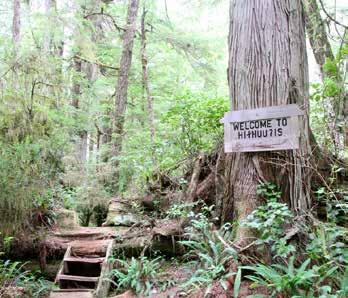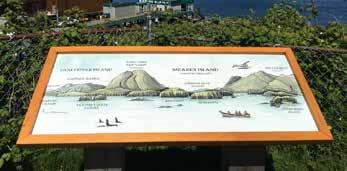
5 minute read
WALKING IN THEIR FOOTSTEPS
WALKING IN THEIR FOOTSTEPS KEALY DONALDSON
WHERE THE BIG CEDAR LIVE
Advertisement
MEARES ISLAND, CLAYOQUOT SOUND Meares Island © Adobestock / Annee
Hilthuu? is the Tla-o-qui-aht place name for Meares Island. Hilthuu? Is a significant part of the Haahuulthii—traditional territory, resources, rivers, songs and names of the Tla-o-qui-aht Hawiih Hereditary Chiefs. Meares Island is one of the many islands surrounding the Village of Tofino, British Columbia. It received its English name in 1862 by George Henry Richards, captain of HMS Hecate, honoring of John Meares. Located in Clayoquot Sound, it is the location of Opitsat, the main village of the Tla-o-qui-aht First min (Kennedy Lake) in 2007. On the 30th anniversary
Nations, and was the location of a US fur-trading post, Fort Defiance, founded by Captain Robert Gray.
In the early 80s, Meares Island was in immediate danger of clear cut logging. Concerned Tofino residents, environmentalists, and the Nuu-chah-nulth First Nations joined together to face off the big timber industry. This initial battle ground gave birth to BC’s “War of the Woods” which spread up to the Queen Charlottes and culminated into the largest act of peaceful disobedience in Canadian history!
Meares Island became historically significant in 1984, when the Nuu-chah-nulth began protesting forestry giant MacMillan Bloedel's potential harvesting activities. The Nuu-chah-nulth, with significant coopered a blockade, preventing MacMillan Bloedel from logging the island. Both sides pursued legal action, and the court ruled that since the Nuu-chah-nulth had claimed that this was part of their traditional territory, until that claim was resolved, no development could occur on the whole of Meares Island. This essentially granted an injunction in favour of the Nuu-chahnulth, which was the first time in British Columbia's history that the province had been overruled on a land claims issue.
After declaring Meares Island a tribal park in 1984, the Tla-o-qui-aht extended parks declarations to Ha'uukation from environmental groups, eventually erect-
of 1984's historic events, they declared Tranquil Creek and Esowista (one of three Tla-o-qui-aht communities, located on Long Beach) Tribal Parks.
The trees on Meares Island, age between 800 and 1,300 years, and are incredible to just stare at and connect with. Explore the fern carpeted forest floor and to hug some of the hugest and oldest life forms on this precious planet.
From Tofino you can take a 10 minute boat cruise to Meares Island and visit the Big Tree trail or Lone Cone trail to hike to the Island’s summit for an eagles’ view of the surrounding area.



boardwalk leading you past many features of special interest to the Hanging Garden Tree which has a circumference of 18.3 meters and a height of 42.7 meters! The board walk is 620 meters in length and takes approximately 1.5 hours return to enjoy.
Depending on the tide, you can visit the mud flats which are extremely important to migratory birds for rest and feeding on their west coast flying routes. Along the route, small islands lay along the edge of Meares Island.
Lone Cone Hike is a 6.5 km return hike and is steep and difficult. The elevation gain is approx. 730 m. The initial hour is gradual and then the steep ascent, approximately 45 degrees is a grueling climb. Definitely allow 6 hours for this trail; there are the most amazing views of local islands and the open Pacific. Be sure to be prepared with good all-weather clothing and gear for the incredible Lone Cone Hike.
It truly is a beautiful marvel, Meares Island, hosting some of the oldest Red Cedar trees In British Columbia, and is the magnificent backdrop to the Village of Tofino.
CAMPBELL RIVER, BC

250-286-3344 • THUNDERBIRDRVPARK.COM
OCEAN • BEACH • ESTUARY • WILDLIFE • BIRDS Autumn Stormwatching in Style & Comfort! ALL SAFETY PROTOCOLS IN PLACE



OPEN ALL YEAR ROUND
WATERSIDE COTTAGES • 1 & 2 BEDROOM OCEANVIEW RV SITES 30 & 50 AMP SERVICE
TBIRDATTYEESPIT VANCOUVER ISLAND, BC
VANCOUVER ISLAND’S LARGEST SUPPLEMENT & FITNESS STORE

Your 1 Stop Shop For All Your Fitness Needs
COURTENAY CAMPBELL RIVER PARKSVILLE 250.334.0777 250.286.4099 250.586.7442
* Supplements * MMA Apparel/Training Aids * Weights/Equipment * Fitness Accessories * Fitness Equipment Repair
WE ARE ART • LOCAL GALLERY UPDATES

OLIVIA WHETUNG
SUGARBUSH SHRAPNEL
AT CAMPBELL RIVER ART GALLERY
On tour from Vancouver’s Contemporary Art Gallery, Sugarbush Shrapnel is a solo exhibition that investigates Nishinaabe artist Olivia Whetung’s connections to the ecosystem of her home territory on Chemong Lake, Ontario, with a focus on the transmission of Traditional Knowledge Systems, food sovereignty, and the fragility of symbiotic relationships in an era of accelerating climate change. The exhibition running until November 18, 2020 in the Main Gallery at Campbell River Art Gallery.
What has been lost through climate change? How might we remember ecosystems after we have forever altered them? These questions are considered in Stand , a suite of large-scale works comprised of thin panels of wood veneer, bead-embroidered with woodburned lines upon their surfaces. In delicate renderings, Whetung traces the fragile relationships between plants, animals and humans. Resembling half-remembered scenes pulled from the fog of memory, the artist’s images offer the barest edges of an ecosystem in the process of irrevocable change. In a dramatic shift in scale, the beaded pods of Sugarbush Shrapnel encase residual fragments of stone that had exploded from the intense heat of the sap-boiling fire during the Whetung family’s maple syruping process. Resembling tiny tombs or time capsules, the small structures house a valued memory. For Whetung, knowledge is recorded not only in the beaded form, but through the act of beading itself. In this way, beadwork is an index of action, witness and acknowledgement.
In conjunction with Sugarbush Shrapnel, the CRAG has prepared a range of exciting programs for youth and adults, including the Estuary Protection Project Video Series, workshops on cedar weaving and wildcrafted pigments, Super Saturday at Home art kits, and an online discussion with Robin Wall Kimmerer, author of the award-winning book Braiding Sweetgrass: Indigenous Wisdom, Scientific Knowledge, and the Teachings of Plants.






